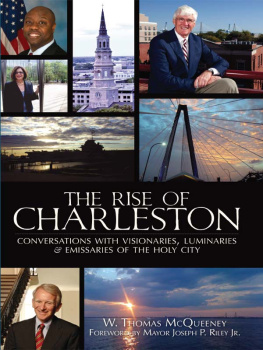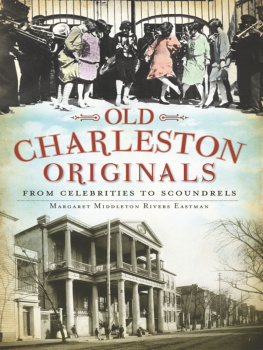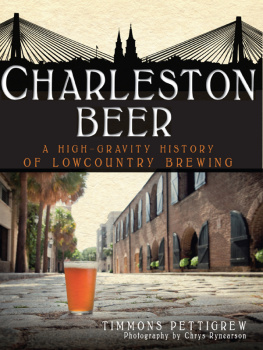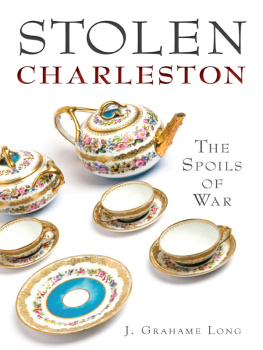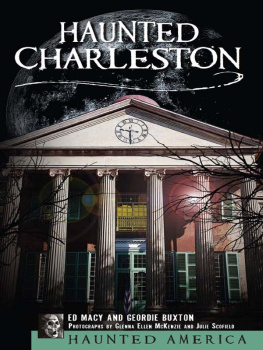
Published by The History Press
Charleston, SC 29403
www.historypress.net
Copyright 2011 by W. Thomas McQueeney
All rights reserved
Cover design by Julie Scofield.
Facing page: Charlotte and Bully McQueeney married in 1947 and then repopulated the globe with nine baby McQueeneys. (Daniel S. McQueeney)
First published 2011
e-book edition 2012
ISBN 978.1.61423.445.6
Library of Congress Cataloging-in-Publication Data
McQueeney, W. Thomas
The rise of Charleston : conversations with visionaries, luminaries, and emissaries of the Holy City / W. Thomas McQueeney.
p. cm.
Includes bibliographical references.
print ISBN 978-1-60949-479-7
1. Charleston (S.C.)--History--20th century. 2. Charleston (S.C.)--History--21st century. 3. Charleston (S.C.)--Biography. 4. Interviews--South Carolina--Charleston. 5. Social change-South Carolina--Charleston--History. 6. Charleston (S.C.)--Social conditions. I. Title.
F279.C457M38 2011
975.7915--dc23
2011038491
Notice: The information in this book is true and complete to the best of our knowledge. It is offered without guarantee on the part of the author or The History Press. The author and The History Press disclaim all liability in connection with the use of this book.
All rights reserved. No part of this book may be reproduced or transmitted in any form whatsoever without prior written permission from the publisher except in the case of brief quotations embodied in critical articles and reviews.

To My Parents
William Thomas McQueeney (posthumously)
&
Charlotte Simmons McQueeney
It was your Charleston first.
Contents
Foreword
Charleston is as much a state of mind as a physical space. From its earliest settlement in 1670, Charleston grew to be one of the principal cities in colonial America. Its importance as a major seaport helped to create many fortunes based on the cultivation of indigo and rice. This early prosperity enabled the construction of superb architecture in both public and private buildings throughout the eighteenth and well into the nineteenth centuries. Charleston became a leader in the arts, architecture and commerce.
Nowhere is a citys or a regions history one of uninterrupted progress and success. Both natural and man-made calamities befell Charleston in the late nineteenth and early twentieth centuries. Recovery from the Civil War was slow, and the earthquake of 1886, the tornado of 1938 and a number of hurricanesthe worst of which was Hurricane Hugo in 1989as well as a number of economic maladies took their toll on the city and the whole region. What these phenomena did not take into account was Charlestons resilience, its ability to rebound and to learn from its misfortunes.
Since the late 1970s, Charleston has shown its resilience, and the entire region has entered a new era of growth, splendor and progress. Economically, the area has become fully diversified, and a number of healthy industries have sprung up to offer a wide variety of employment to citizens. Tourism, manufacturing, high technology and construction provide many opportunities.
I first ran for mayor of the City of Charleston in 1975. There were many reasons for running, but none was more important than helping this city and region to heal racial differences. A long and troubled history of racial animosity kept Charleston from realizing its potential, and I knew that until we squarely faced and met that challenge, real progress would not be possible. It was not a question of replacing some people at the decision-making table; it was a matter of making the table bigger and giving everyone a place. We certainly have much more work to do, but I am proud of how far we have come and what a difference this racial reconciliation and inclusiveness has made to the real accomplishments in every facet of life in Charleston since the late 1970s.
I also wanted to help Charleston regain its economic footing, to revitalize the downtown business district and to spread this new growth and progress to our suburban neighborhoods. We started with a plan and followed it through many challenges. The King Street shopping district, truly unique, is one of the most successful downtown spaces in America.
Tourism has become a major industry in Charleston, but we devote as much time to tourism management as to tourism promotion. It is a delicate balance that must be maintained, for it would be fatal to tip the balance in either direction.
I realized that a central city like Charleston had to be able to grow to provide the services that were expected and provided for the entire region, and in the past thirty-five years, the physical size of the city has grown from ten to more than one hundred square miles, from Daniel Island to Johns Island, from Bees Ferry to the Battery.
Public spaces define a city and its values, and Charleston has worked hard to build on its tradition of an inspiring public realm. From the Waterfront Park on the site of burned-out docks on the Cooper River to the brand-new recreation complexes across the area, the public realm has grown geometrically and been enhanced by new parks that take advantage of this areas beautiful natural resources in both North Charleston and Mount Pleasant.
Sports venuesfrom our beautiful baseball stadium with its river views to the fabulous Family Circle Tennis Stadiumhelp attract new residents and entertain those of us who are already here. The phenomenal growth of higher education in Charlestonthe College of Charleston and the Art Institute in particularprovide opportunities for higher education and for jobs.
Charleston has experienced in the last few years an enormous explosion as a center for the arts. Spoleto Festival USA, the Moja Festival and the growth of the visual arts have made possible the restoration of the Dock Street Theatre and the planned renovation of the Gaillard Auditorium into a world-class performing arts space.
Charleston is truly cosmopolitan, the result of its long history as a thriving port, carrying goods from one part of the world to another. This trait, coupled with the efforts to make our public realm as beautiful and user-friendly as possible, have helped to land Charleston high on most national or international lists of best places to live. It is important not to forget that Charlestons situation on the water is what made the city and the area great places to live. Shipping and related activities have long been a key component of the local and state economy.
While the built environment is critical to a regions success, nothing is more important than the people who make it all happen. The people you will read about in this book are many of the talents that make this community so successful. Their diversity shows the hundreds of strands of effort and inspiration that have contributed to making Charleston an incomparable place to live. And they all share in common the realization that we must never rest on these laurels. There must always be more to do.
Joseph P. Riley Jr.
Mayor
City of Charleston, South Carolina
Acknowledgements
Oh, and by the way
That seems to be a thematic part of everyones life in the Holy City. In Charleston 1960 as in Charleston today, it was a way of saying, Did you know that so-and-so is the first cousin of this person who married that person? Interjections like Well, I declare or Isnt that grand? were always a staple part of the lexicon.
Next page
